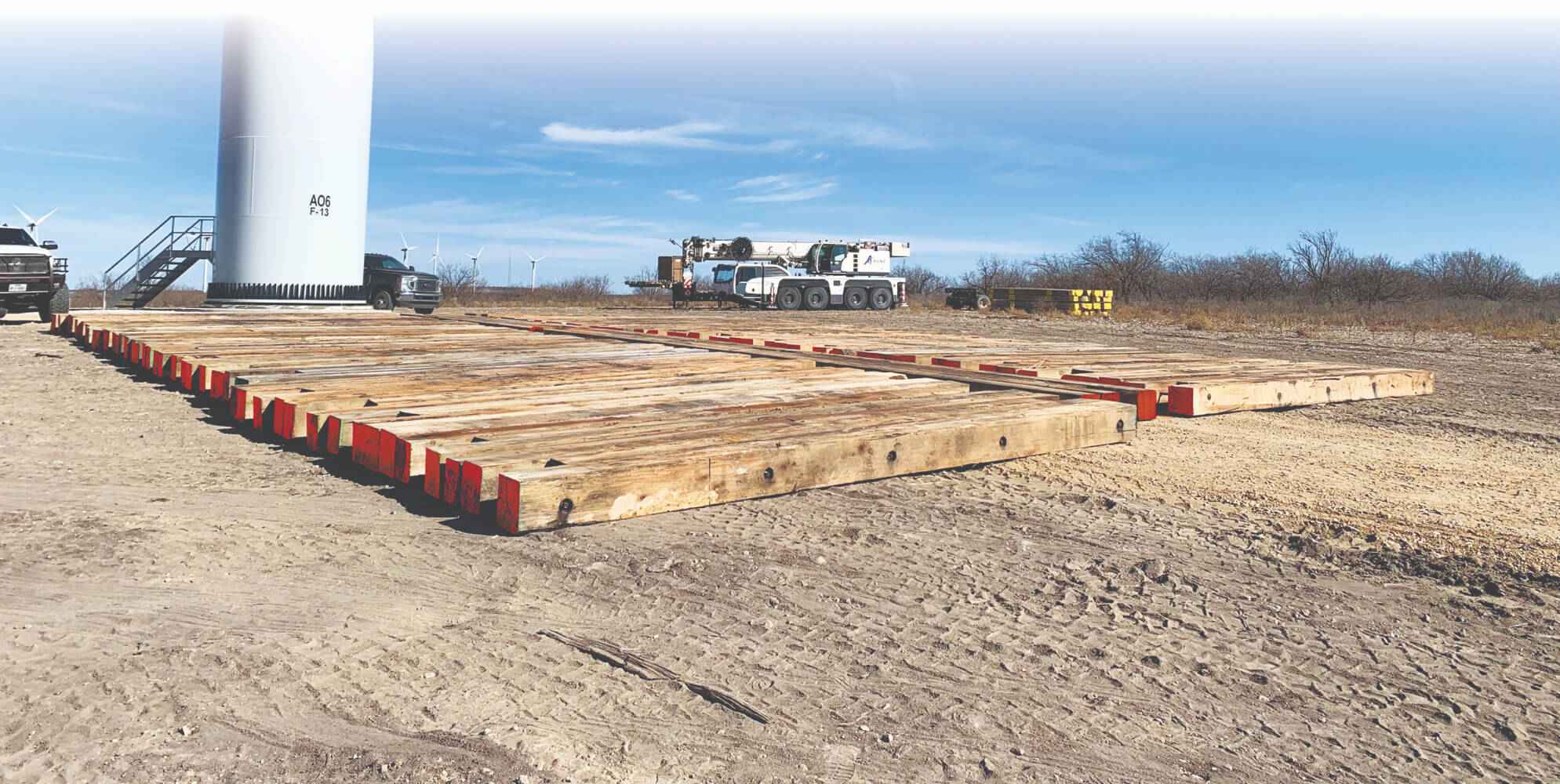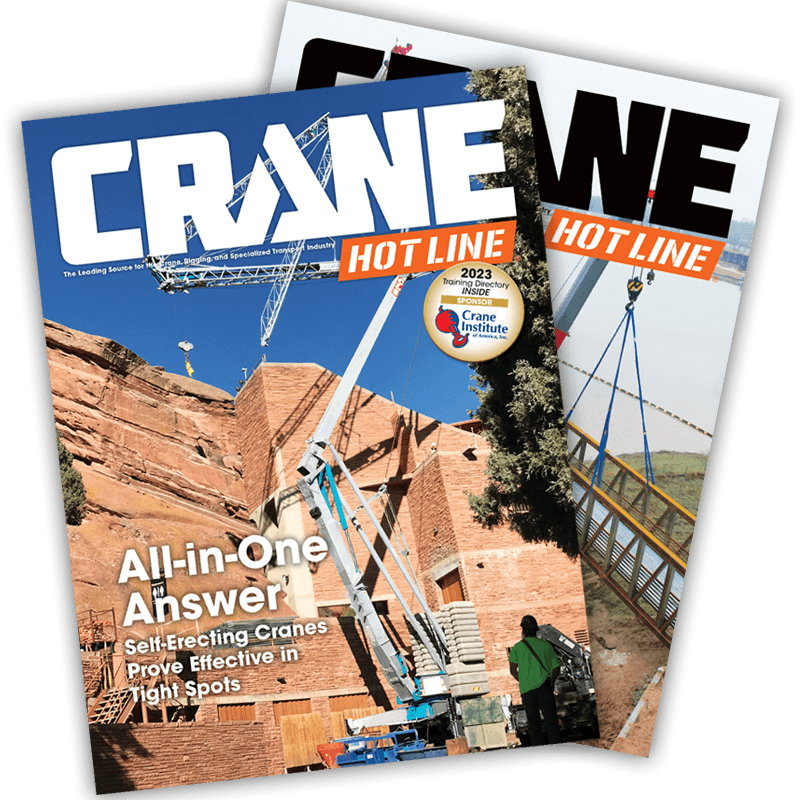Acing Ground Support
Benefits of mats and pads for access and lifting safety
Safety is critical on every construction project, but when heavy cranes are involved, there is no room for errors or shortcuts, especially when it comes to ground support design. Cranes have toppled when they’ve been walked across areas with inadequate ground support or unstable subgrade and when outriggers have punched through soft ground.
Even when ground stabilization studies indicate the ground is stable enough to operate on, unseen voids may be present, and objects to be lifted, such as trees, may weigh more than estimated, increasing the ground bearing pressure. In addition, soil conditions may change — the ground may soften in wet weather, and cold weather can cause frost heave.
Hardwood and composite mats and pads create much safer environments for crane mobilization and operations, especially in access and lift areas with soft, wet or shifting soil. They help protect crane operators, nearby workers and residents, the cranes and the loads they pick. Properly selected and installed mats provide a crucial safety buffer. They also reduce costly project delays.
Advantages of Mats
Aggregate roads are a common solution to access needs, but they aren’t perfect. They often require significant excavation and grading prior to installation. They can shift and sink in muddy conditions, becoming unlevel and potentially developing ruts. Removing the stones at the end of a project is laborious and expensive. Disposing of them adds extra cost.
Building up a gravel and dirt road above the water table or installing stone to access swamps, marshes, agricultural fields and other ecologically sensitive areas requires permits, which often take weeks or months to obtain. The permitting process not only delays the start of a project but also adds an element of unpredictability to the job, since permits may be denied.
Timber mats, which float over wet ground and streams, are an ideal fast-track solution. Hardwood timber mats:
- Are quick to install.
- Create a solid, level surface that remains in place over time.
- Increase traction.
- Are easy to reposition and remove.
- Are reusable.
- Evenly distribute the weight of the crane, which reduces soil compaction and therefore runoff.
In the past, timber outrigger mats were a standard choice, but many companies have embraced composite outrigger pads in recent years as another option for creating access for equipment, including lighter cranes. Light and easy to transport and position, they are impervious to water and rot and resistant to chemicals. They last much longer than timber mats — at least a decade — though the initial cost is slightly higher.
In addition, permits are not always required for access roads and equipment platforms made of mats because they don’t permanently disturb the ground or require excavation or fill. By distributing the weight of the crane, they minimize rutting, soil compaction and damage to vegetation or topsoil.
Work pads constructed of 12-inch-thick hardwood timbers support and stabilize heavy cranes, including crawler cranes, as they pick and move loads. Their load-bearing capacity is second only to that of steel mats, and timber crane mats cost a fraction of the price of steel mats. When the ground is unlevel or the soil is soft, muddy, sandy, backfilled or loosely compacted, installing a timber crane mat under the entire crane area is a smart precaution.
In the absence of a crane mat, outrigger support is often necessary for cranes. Failure to use adequate cribbing and dunnage or appropriate mats or pads to support and level the outriggers can cause one or more outriggers to sink, altering the crane’s center of gravity and throwing the crane off balance. While many crane companies rely on cribbing and dunnage, outrigger mats or pads create a larger contact area and provide a more reliable solution.

Sourcing Options
Purchasing high-quality timber or composite mats requires a significant capital expenditure. Renting mats instead of owning offers advantages, especially for smaller and shorter-term projects.
Financially, renting allows crane companies to conserve capital, which preserves cash flow and frees up funds for other investments. When companies rent mats, there are no chargebacks at the end of the project for mats that are decayed or broken; all costs are upfront costs.
Logistically, renting averts the need to transport mats from one jobsite to another and pay to store them between projects, as mat rental vendors typically handle delivery, placement and pickup. When rental mats are available near the project location, companies can realize considerable savings on transportation costs, especially compared to transporting owned mats to and from jobsites that sit hundreds of miles apart.
Leveraging rental mats also removes the burden of maintaining the mats and replacing them when they degrade. Finally, renting offers the flexibility to change mats based on the application and jobsite, whereas purchasing commits companies to one type and brand of mat.
Choosing a Provider
An experienced matting provider who understands crane operations and the permitting landscape can help crane companies work more safely and efficiently by recommending mat types based on the required ground bearing pressure, the terrain and the project length. They will advise on mat placement and provide an engineered mat layout if needed to ensure even weight distribution under cranes and avoid damaging the ground.
Crane work is dangerous work, but tip-overs are largely preventable. The right mats and pads help crane operators lift with increased confidence. By pointing companies to ideal ground stabilization solutions, an experienced rental mat partner can help them reduce risk, ensure regulatory compliance, eliminate permit-related delays and preserve operational uptime.
Lawrence St. John, vertical sales specialist, Matting Solutions at United Rentals, is a ground protection matting industry expert with over 16 years of experience in sales, rentals and project management across the U.S. In his current role, he focuses on providing ground protection support to help clients navigate complex jobsite challenges.




